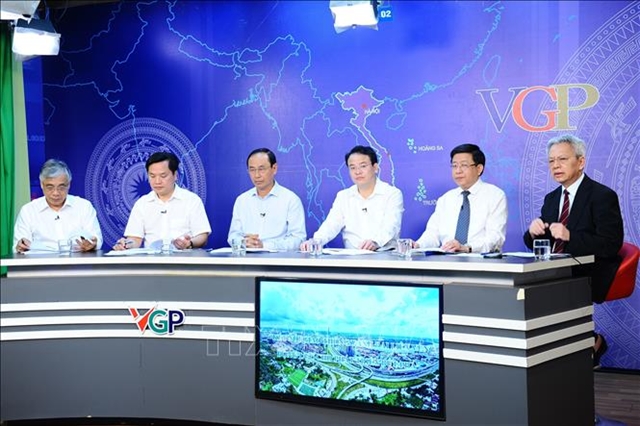 Society
Society


|
| Six experts and officials joined the seminar panel to discuss infrastructure projects on Wednesday. — VNA/VNS Photo Minh Đức |
HÀ NỘI — HCM City's Ring Road No 3 and Capital Region Ring Road No 4 are crucial to regional linkages and spurring economic growth.
Participants discussed the crucial role played by the roads during an online seminar titled "Connecting inter-regional traffic - key to breakthrough developments" organised by the Vietnamese Government Portal on Wednesday.
Experts and officials answered questions and debated important traffic and transportation projects.
Infrastructure development is one of three strategic breakthroughs identified by the Party and the Government, and the Resolution of the 13th Party Congress made it clear that Việt Nam will build a synchronous and modern infrastructure system to benefit both the economy and society. One of the targets set in the 2021-25 period is to complete 2,000km of highways, on top of the 1,000km already completed.
The Ring Road No 3 project in HCM City and the Ring Road No 4 project in Hà Nội are two of the key traffic projects that are actively being invested in. The two projects will be submitted for consideration and decision on investment policies at the 3rd session of the 15th National Assembly.
"Hà Nội currently has six highways that lead to the city centre," said Dương Đức Tuấn, Deputy Chairman of Hà Nội People's Committee. "Ring Road No 4 will connect northern provinces with the east entrance of the North-South expressway, which leads to HCM City's No 3 Ring Road."
"This will lead to new possibilities of development, as well as enable the expansion of socio-economic development in rural regions. Ring Road No 4 will also connect Nội Bài International Airport with the capital's planned second international airport down in southeastern Hà Nội, which in turn, also links with the North-South high-speed railway," said Tuấn.
As for HCM City's No 3 Ring Road, Trần Quang Lâm, Director of HCMC's Department of Transport, said: "The Ring Road project is crucial in connecting four central highways, as well as four surrounding provinces in the Southern Key Economic Zone, which accounted for 45 per cent of Việt Nam's GDP."
"Ring Road No 3 will help solve traffic jams in provincial centres, and open up new possibilities such as new industrial zones and new connections between provinces in the region. New expressway systems to neighbouring countries are also achievable and would help the competitiveness of Việt Nam's economy."
"It's high time that these projects are started," said Trần Quốc Phương, Deputy Minister of Planning and Investment. "We don't currently have enough highways and expressways that need to advance the development of the country, therefore it's reasonable that these projects be completed in the near future."
The Ring Road No 4 project for the Capital region is invested heavily with a mix of public investment and public-private partnership investment. According to Tuấn, the total investment of the project is VNĐ85.8 trillion (US$3.7 billion), divided into three segments. Of which, segment 1 is for site clearance, segment 2 is for the lower urban road project and group 3 is for one project under the public-private partnership (PPP) model, of which investors are responsible through a BOT contract. Investment funding of segments 1 and 2 shall be covered by the central and local budgets, while segment 3 is undertaken by BOT investors with a total investment of VNĐ29.4 trillion.
The central and local budgets have been relatively balanced in the medium-term public investment plan for the 2021-25 period. Accordingly, for the Government, the balance is expected to be VNĐ28 trillion. The balance for Hà Nội, Bắc Ninh and Hưng Yên will be over the VNĐ28 trillion mark, of which the priority of the budget goes to Hà Nội, Bắc Ninh and Hưng Yên respectively.
The three localities that are implementing lower urban road projects should likely have capital until 2026, and the investment progress must be consistent with the process of constructing the whole Ring Road route. The PPP-BOT project with a scale of VNĐ29.4 trillion must be completed by 2025.
But the difficulties of Capital Region's Ring Road No 4 project lie mostly in the site clearance part, with the area of clearance remarkably large: 1,341ha of land that costs VNĐ19 trillion to clear for the three aforementioned localities.
Hà Nội itself must have a remuneration project for 14,647 households and relocation plans for 2,203 households that lie within the project site.
As for the capital mechanism for investment, Deputy Minister of Transport Lê Đình Thọ said, on the basis of implementing phase 2 of the Eastern Expressway project already approved by the National Assembly, the Government considers inquiring about a specific policy to the National Assembly for HCMC Ring Road 3 and Capital Region Ring Road 4 projects.
Accordingly, the Government will apply for permission to flexibly use Central and local budget funds for project development, as well as increase the total medium-term investment in the public investment plan for the 2021-25 period from the expected capital collected from localities and bonds issued for localities to borrow, especially in the 2024-25 period. Localities are responsible for balancing local budget revenues, including land use revenues, to repay their loans to local budgets in the 2026-30 period. — VNS




